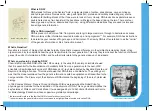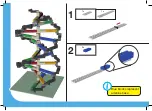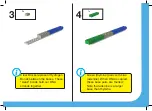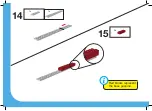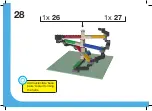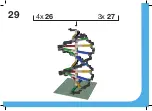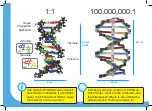
What is DNA?
DNA stands for Deoxy-ribo Nucleic* Acid, a molecule made of carbon, phosphorous, oxygen, nitrogen
and hydrogen atoms. Nucleic acids, along with lipids (fat), proteins and carbohydrates (sugars), are the
fundamental building blocks of life. If one were to look at it very closely, DNA looks like a spiral staircase or
double helix made of two banisters (the backbone) with steps (the bases) linking the two. There are four
bases (guanine, cytosine, adenine and thymine) - using different combinations they are used to store and
transmit genetic information.
Why is DNA important?
DNA is present in all forms of life: from plants and fungi to large mammals, through to bacteria and viruses.
DNA contains all the information required to make up a living organism**. For example, DNA has instructions
to determine your number of fingers, eye and hair colour. That is why DNA is often referred to as the “carrier”
of the genetic information or life’s 'instruction manual'.
What is Genetics?
Genetics is a branch of biology that studies heredity. Geneticists measure differences in the visible characteristics (traits) of live
organisms and try to understand how they are transmitted to the next generation. This way, they learn about the function of different
genes (the units of information in DNA), and how the traits relate to the genetic make-up of individuals.
What can we learn by studying DNA?
Chemists first identified DNA in the late 19th century. In the early 20th century, scientists showed
that it is essential for the transmission of hereditary traits from one generation to the next. LMB
scientists in Cambridge built a model of DNA based on X-ray data collected by Rosalind Franklin and
Raymond Gosling in London. This model showed that DNA forms a double-helix. The exciting part
was that the model explained how the genetic information could be duplicated and transmitted to the
next generation. The discovery of the structure of DNA marked the beginning of the era of molecular
biology.
In 1962, James Watson, Francis Crick and Maurice Wilkins were awarded the Nobel Prize for
physiology and medicine for their elucidation of the structure of DNA. This Lego model simplifies the
key features of Watson and Crick's Model. It was designed by John Schollar at the National Centre
for Biotechnology Education, whose support we gratefully acknowledge.
* the term nucleic refers to the fact that DNA is found in the nucleus of cells.
**
in some viruses the genetic information is contained in a slightly different nucleic acid called RNA.
James Watson and Francis Crick
Francis Crick sketch 1953.
Содержание 1953
Страница 1: ...1953 ...
Страница 3: ...1 2 Blue blocks represent adenine base 1x 1x 2x ...
Страница 6: ...8 9 1x 2x 1x ...
Страница 7: ...10 11 2x 2x ...
Страница 9: ...14 15 Red blocks represent the base guanine 1x 1x 2x ...
Страница 10: ...16 17 Yellow bricks show cytosine which pairs with guanine notice the difference between the sizes 2x 1x ...
Страница 11: ...18 19 20 2x 2x 1x ...
Страница 12: ...21 23 22 24 2x 2x 2x 1x 2x ...
Страница 13: ...25 Add this base pair red yellow to the base blue green to make the first turn of your double helix ...
Страница 14: ...26 27 Repeat steps 14 24 Repeat steps 1 8 10 13 ...
Страница 15: ...28 1x 26 1x 27 Add nucleotide base pairs to start forming the helix ...
Страница 16: ...4x 26 3x 27 29 ...


